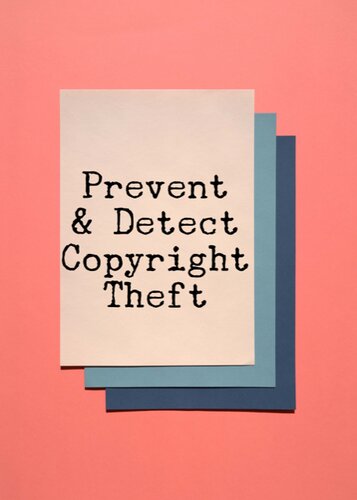by Carolyn Edlund
Concerned about infringement of your copyrighted art and images? Here are ways to protect yourself, find out about infringement, and take action.

Prevention of copyright theft begins with you as the artist. Under U.S. law, you own the copyright to your creative work as soon as it is created. However, putting images of your art on the internet exposes you to the risk of infringement. This means that others could potentially place your images on other websites without permission or attribution. Or, they could be printed as “reproductions” and sold by other parties. How can you lessen the chance that this will happen?
Use low resolution images online
Images with smaller file sizes (also called low-resolution or low-res) cannot be printed out without causing pixelation, and thus are useless to people who would sell your art as their own. Low-res images load faster on websites as well, and are standard for online use. You can compress your images here before you place them on a website.
Use watermarks
Watermarks can be used effectively to keep others from using your art images without permission. They vary from subtle watermarks to bolder ones that make it more difficult and undesirable to steal. However, keep in mind that heavy watermarks can be distracting, so if you are selling your art you will want to make them less obtrusive and easier for potential customers to view.
It’s easy to use a program like Photoshop or Paintshop to create watermarks. Or, use an online generator like MakeWatermark or Watermarkly, which are free tools.
Show work in situ
One way to alleviate concerns about copyright theft is to share your art shown in an in situ photo. Although the photo of the work in the setting might be copied and shared, your artwork could not be stolen and reproduced as a product for sale. In situ photos may also show artwork at an angle, which makes the image unusable for thieves.
Register your copyrighted work
Proof positive of ownership of your copyrighted materials can be obtained by registering your artwork with the U.S. Copyright Office. Learn more about that process here.
If you want to allow others to use your images online, but would like to set conditions (such as attribution) Creative Commons is a site with tools to help you do that.
How can you detect whether other people have infringed on your copyrights by placing images online without permission?
Tin Eye offers a “reverse image search” function that helps you determine where your photos are shown online, and it’s free to use. Simply upload your file, or enter the image URL, and it will search for other sites where the image resides. This puts you in a position to see whether there is infringement taking place.
Pixsy is a site devoted to helping artists, photographers and others detect and enforce their copyrighted work through their legal team, which keeps 50% of any settlements they collect on your behalf.
The experience of having your work infringed upon can be stressful, but there are self-help techniques to deal with it. One of the first steps that any artist can take when they find evidence of infringement is to send a DMCA takedown notice. This often resolves the problem. Lawsuits can be time-consuming and expensive, and having the image removed from the offending site may be satisfactory for you.



Speak Your Mind